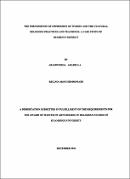| dc.description.abstract | This study investigated the oppression of women in the case study area-Bushenyi District.
ln chapter one, the dissertation identified the back ground of the study, the statement of the
problem, hypothesis, objectives, scope and the significance of the study, review of related
literature, methodology, constraints, solutions and the definition of the terms.
All over the world, women have been oppressed, abused physically, emotionally, socially,
economically and in all aspects of life. Despite some laws put forward to protect the human
rights and existence of formal education, the study revealed that still women experience
oppression of various forms. For instance beatings harr The researcher therefore discovered this
problem worldwide, on country level that is in (Uganda) and District level (Case study of
Bushenyi District).
The population of the study comprised of women, men, church leaders, probation officer and
Local councils. The researcher used both qualitative and quantitative approaches of data
collection. The tools used in data collection were questionnaires, oral interviews, focus group
discussion, observation and document review.
The researcher was guided by both main and specific objectives of the study as categorized in
different chapters of the study. The first specific objective of the study was discussed in chapter
two as it examined the existing oppressive cultural beliefs and practices among Banyankole in
Bushenyi District. That is oppressive taboos, proverbs and sayings.
The second objective of the study in chapter three identified the effects of oppression of women
in Bushenyi District, for example; loss of self-esteem, poverty, diseases, divorce and separation,
hatred and death. The study showed the third specific objective in chapter four as; the
paradoxical nature of religious teachings on oppression of women. These included; both New
and Old Testament teachings in the bible, the Islamic teachings that encourage and discourage
oppression of women.
Chapter five of the study found out the possible solutions to women oppression in Bushenyi
District as stated as the fourth specific objective of the study.
The study discovered that there is oppression of women in Bushenyi District. It was also found
out that the cause of oppression of women is mainly due to upbringing and oppressive cultural
beliefs and practices. There were also other ways of oppression of women like some religious
teachings and modern ways like due to technology, media, education, employment. | en_US |

